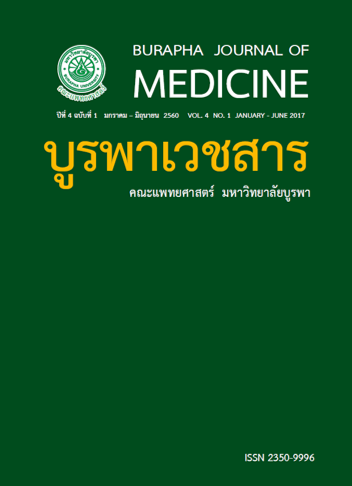ผลของการฝึกผ่อนลมหายใจออกช้าโดยการเป่ากังหันลมต่อความดันโลหิต ในผู้ป่วยโรคความดันโลหิตสูง
คำสำคัญ:
ผ่อนลมหายใจออกช้า, ความดันโลหิต, ผู้ป่วยโรคความดันโลหิตสูงบทคัดย่อ
Objectives To assess the effect of slow breath training program on the blood pressure (BP) in
hypertensive patient
Methods A randomized controlled trial was study between December 2015 and February
2016 in Bangwau Health Promoting Hospitals, Bangpakong District, Chacheongsao Province. 60
hypertensive patients were randomly allocated to the intervention group (n=30) of slow breath
training program and usual medical care or to a control group (n=30) of only usual medical
care. The primary analysis was comparing BP change from baseline to final visit both groups
at 8 weeks’ follow-up.
Results 56 participants were analyzed, 4 participants in intervention group were excluded
due to 2 participants discontinued breath training program and the others loss of follow-up
however no adverse events. The study found that intervention group was improvements in
systolic BP (SBP) -7.5 mmHg (95% confidence interval(CI), -11.5 to -3.4 mmHg), diastolic BP (DBP)
-4.4 mmHg (95% CI, -7.1 to -1.6 mmHg), and mean arterial pressure (MAP) -5.4 mmHg (95% CI,
-8.1 to -2.7mmHg). The control group showed increase in SBP 5.5 mmHg (95% CI,-0.95 to 10.1
mmHg) but DBP and MAP was not significant BP change from baseline. The comparing between
intervention and control group showed SBP change (-7.5 mmHg Vs 5.5 mmHg, respectively;
difference 13 mmHg 95% CI, 6.94 to 19.05; P<0.01) and MAP change (-5.4 mmHg Vs 0.9 mmHg,
respectively; difference 6.3 mmHg 95% CI, 2.47 to 10.03; P<0.01), unfortunately DBP was not
significant difference.
Conclusion Over an 8-weeks treatment period, slow breath training program is effective in
reducing blood pressure in hypertensive patients.
เอกสารอ้างอิง
การรักษาโรคความดันโลหิตสูงในเวชปฏิบัติทั่วไป
ฉบับปรับปรุง พ.ศ. 2558. กรุงเทพมหานคร; 2558
2. ทักษพล ธรรมรังสี. รายงานสถานการณ์โรค NCDs
วิกฤตสุขภาพ วิกฤตสังคม.นนทบุรี: สำนักวิจัย
นโยบายสร้างเสริมสุขภาพ(สวน.) สำนักงานพัฒนา
นโยบายสุขภาพระหว่างประเทศ (International
Health Policy Program); 2557
3. สำนักงานหลักประกันสุขภาพแห่งชาติ.คู่มือ
แนวทางการรักษาโรคความดันโลหิตสูงในเวช
ปฏิบัติทั่วไป พ.ศ. 2551. กรุงเทพมหานคร: บริษัท
สไตล์ครีเอทีฟเฮ้าส์จำกัด.
4. Kaushik RM, Kaushik R, Mahajan SK, Rajesh
V. Effects of mental relaxation and slow
breathing in essential hypertension.
Complement Ther Med. 2006; 14(2): 120-
6. Epub 2006 Jan 10.
5. Park E, Oh H, Kim T. The effects of relaxation
breathing on procedural pain and anxiety
during burn care. Burns. 2013; 39(6): 1101-6.
doi: 10.1016/j.burns.2013.01.006. Epub 2013
Feb 1.
6. Patel HM, Kathrotia RG, Pathak NR, Thakkar
HA. Effect of relaxation technique on blood
pressure in essential hypertension. NJIRM
2012; 3(4): 10-14.
7. จมาภรณ์ ใจภักดี, กมล อุดล, ปรารถนา สถิตย์วิภาวี,
พนม เกตุมาน. ผลของการฝึกหายใจแบบลึกร่วม
กับการผ่อนคลายกล้ามเนื้อต่อระดับความดัน
โลหิตและความเครียดในผู้ป่วยความดันโลหิต
สูง. Graduate Research Conference. 2014.
[cited 2015 Oct 10]. Available from: https://
gsbooks.gs.kku.ac.th/57/grc15/files/mmp64.pdf
8. Anderson DE, McNeely JD, Windham BG.
Regular slow-breathing exercise effects
on blood pressure and breathing patterns
at rest. Joumal of Human Hypertension.
2010; 24(12): 807-813. [cited 2015 Oct 12]
Available from: http://www.gnmhealthcare.
com/pdf/03-2010/04/jhh_vaop_ncurrent_
gnm_jhh201018a.pdf
9. Mourya M, Mahajan AS, Singh NP, Jain
AK. Effect of slow- and fast-breathing
exercises on autonomic functions in
patients with essential hypertension. The
journal of alternative and complementary
medicine. 2009; 15(7): 711-717. doi:10.1089/
acm.2008.0609. [cited 2015 Oct 12]
10. มาณีย์ อุ้ยเจริญพงษ์, เบญจพร ทองเที่ยงดี. การ
หายใจช้าช่วยลดความดันโลหิตในผู้มีความดัน
โลหิตสูง.วารสารสาธารณสุขมหาวิทยาลัยบูรพา
2554. [เข้าถึงเมื่อ12 ตุลาคม2558];6:41-47. เข้า
ถึงได้จาก: http://digital_collect.lib.buu.ac.th/
journal/Public_Health/v6n2/p41-47.pdf
11. Oneda B, Ortega KC, Josiane LG, Tatiana
GA, Jr DM. Sympathetic nerve activity
is decreased during device-guided slow
breathing. Hypertension Research 2010; 33:
708–712. doi:10.1038/hr.2010.74 [cited 2015
Oct 12]
12. Limberg JK, Morgan BJ, Schrage WG,
Dempsey JA. Respiratory influences on
muscle sympathetic nerve activity and
vascular conductance in the steady state.
Am J Physiol Heart Circ Physiol. 2013;
304(12): H1615–H1623. [cited 2015 Oct 12]
Available from: http://ajpheart.physiology.
org/content/ajpheart/304/12/H1615.full.pdf
13. วัฒนา วัฒนาภา, สุพัตรา โล่ห์สิริวัฒน์, สุพรพิมพ์
เจียสกุล, บรรณาธิการ. สรีรวิทยา 2. พิมพ์ครั้ง
ที่ 5. กรุงเทพมหานคร: ภาควิชาสรีรวิทยา คณะ
แพทยศาสตร์ศิริราชพยาบาล มหาวิทยาลัยมหิดล.
2548.
14. Joseph CN, Porta C, Casucci G, Casiraghi N,
Maffeis M, Rossi M, et al. Slow breathing
improves arterial baroreflex sensitivity
and decreases blood pressure in essential
hypertension. American Heart Association.
2005; 46: 714-718. doi: 10.1161/01.
HYP.0000179581.68566.7d [cited 2015 Oct 12]
15. Viskoper R, Shapira I, Priluck R, Mindlin R,
Chornia L, Laszt A, et al. Nonpharmacologic
treatment of resistant hypertensives by
device-guided slow breathing exercises. Am J
Hypertens. 2003; 16: 484-7. [cited 2015 Oct 12]
Available from: http://www.ajmedical.
se/7th%20clinical%20trial%20Resperate.pdf



